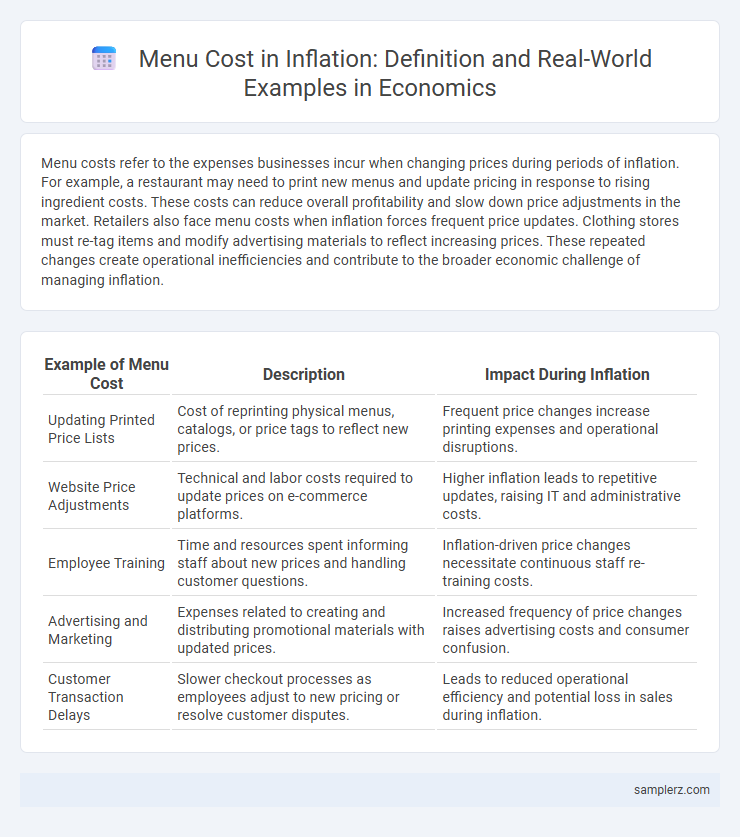Menu costs refer to the expenses businesses incur when changing prices during periods of inflation. For example, a restaurant may need to print new menus and update pricing in response to rising ingredient costs. These costs can reduce overall profitability and slow down price adjustments in the market. Retailers also face menu costs when inflation forces frequent price updates. Clothing stores must re-tag items and modify advertising materials to reflect increasing prices. These repeated changes create operational inefficiencies and contribute to the broader economic challenge of managing inflation.
Table of Comparison
| Example of Menu Cost | Description | Impact During Inflation |
|---|---|---|
| Updating Printed Price Lists | Cost of reprinting physical menus, catalogs, or price tags to reflect new prices. | Frequent price changes increase printing expenses and operational disruptions. |
| Website Price Adjustments | Technical and labor costs required to update prices on e-commerce platforms. | Higher inflation leads to repetitive updates, raising IT and administrative costs. |
| Employee Training | Time and resources spent informing staff about new prices and handling customer questions. | Inflation-driven price changes necessitate continuous staff re-training costs. |
| Advertising and Marketing | Expenses related to creating and distributing promotional materials with updated prices. | Increased frequency of price changes raises advertising costs and consumer confusion. |
| Customer Transaction Delays | Slower checkout processes as employees adjust to new pricing or resolve customer disputes. | Leads to reduced operational efficiency and potential loss in sales during inflation. |
Understanding Menu Costs: A Brief Overview
Menu costs refer to the expenses businesses incur when changing prices during inflation, such as reprinting menus, updating labels, or altering advertising materials. High inflation rates force frequent price adjustments, increasing these costs and potentially reducing firms' profitability. Understanding menu costs helps explain why companies may delay price changes despite fluctuating purchasing power.
Real-World Examples of Menu Costs During Inflation
During high inflation periods, restaurants frequently update physical menus to reflect rising ingredient prices, incurring printing and design expenses that exemplify menu costs. Retail stores adjusting shelf labels and price tags multiple times within short timeframes face similar costs, impacting operational efficiency. Airlines also regularly reprice tickets using complex algorithms, but managing these adjustments requires significant IT resources and labor, highlighting the broad economic impact of menu costs during inflation.
How Menu Costs Impact Restaurants in Inflationary Periods
Menu costs, which refer to the expenses restaurants incur when updating prices, significantly impact profitability during inflationary periods. Frequent price changes require restaurants to reprint menus, retrain staff, and update digital platforms, increasing operational costs. These expenses often force restaurants to delay price adjustments, potentially reducing revenue and squeezing profit margins amid rising input costs.
Menu Costs in Retail Pricing Adjustments
Menu costs in retail pricing adjustments refer to the expenses retailers face when updating price tags, catalogs, or digital listings during inflation periods. These costs include reprinting menus, labor for changing prices, and customer communication efforts, which can delay price updates and impact profit margins. High inflation amplifies menu costs, forcing retailers to balance frequent price changes against operational efficiency.
Technology Solutions to Mitigate Menu Costs
Menu costs during inflation can be significantly reduced through digital price tagging and automated pricing software. Retailers using cloud-based platforms can instantly update prices across all locations, minimizing the labor and time associated with frequent adjustments. Integrating AI-driven analytics further optimizes pricing strategies by predicting inflation trends and adjusting prices proactively.
Economic Consequences of Frequent Price Changes
Frequent price changes during inflation increase menu costs, including expenses related to updating menus, labels, and advertising materials. These costs reduce firms' profitability and can lead to less efficient resource allocation in the economy. High menu costs also discourage businesses from adjusting prices continuously, potentially causing price rigidities and affecting overall market dynamics.
Case Study: Grocery Chains Facing Inflation and Menu Costs
Grocery chains experience significant menu costs during inflation as frequent price adjustments require reprinting shelf labels, updating digital price tags, and retraining staff, leading to increased operational expenses. For instance, major chains like Kroger and Safeway reported rising costs linked to price changes that occur weekly to keep pace with fluctuating wholesale prices. These menu costs can reduce profit margins and complicate inventory management amid persistent inflationary pressures.
The Hidden Costs of Price Updates for Small Businesses
Small businesses face significant menu costs during inflation as frequent price updates require extensive time and resources for printing new menus, re-tagging products, and informing customers. These hidden expenses reduce profit margins and disrupt operational efficiency, especially for establishments with tight budgets. Efficient price adjustment strategies are crucial to minimize the economic impact on small business sustainability during inflationary periods.
Menu Costs in the Digital Economy Amid Inflation
Menu costs in the digital economy during inflation manifest as frequent price update expenses on e-commerce platforms and mobile apps, requiring businesses to continually revise digital catalogs and user interfaces. These costs include software development for dynamic pricing algorithms and increased labor for constant data analysis to adjust prices in real time. As inflation accelerates, firms face higher operational costs from repetitive digital price tagging and customer communication efforts, impacting profit margins and competitive positioning.
Policy Implications: Reducing the Burden of Menu Costs
Menu costs, the expenses businesses incur when changing prices during inflation, can hinder market efficiency and consumer responsiveness. Implementing digital pricing systems and encouraging real-time price adjustments help reduce these costs, fostering smoother inflationary transitions. Policymakers promoting technological adoption and streamlined regulatory processes can alleviate the economic friction caused by frequent price revisions.

example of menu cost in inflation Infographic
 samplerz.com
samplerz.com